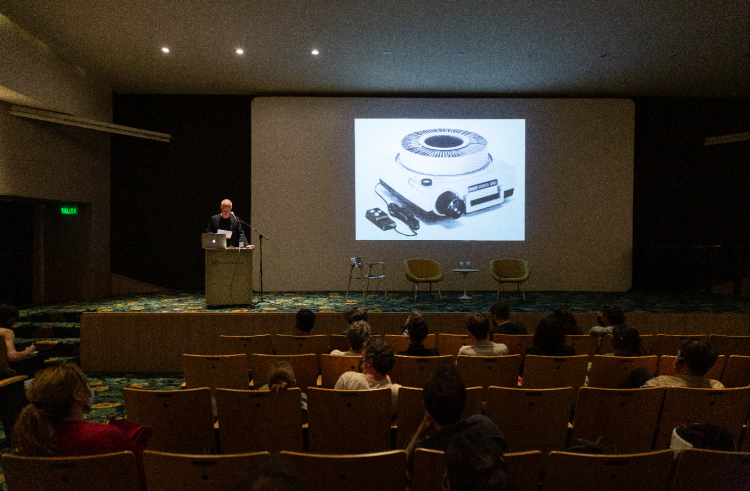#4
Entornos Audiovisuales
Dec, 2021
Photography:
Javier Agustín Rojas
Institutional Support:
Graham Foundation for Advanced Studies in the Fine Arts
As part of the program for the “Pidgeon Audio Visual: Architects Speak for Themselves” exhibition, Columbia University professors Felicity D. Scott and Mark Wasiuta visited Buenos Aires to give a lecture in the auditorium of the Asociación Amigos del Museo Nacional de Bellas Artes. They presented a series of projects and exhibitions produced from research on audiovisual archives, placing the exhibition and the Pidgeon Audio Visual project within a broader context.
Felicity Scott began her presentation brie y reviewing Monica Pidgeon’s career, from Architectural Design to Pidgeon Audio Visual, noting that it could serve to trace the shift in prevalence from graphic media to audiovisual media in architecture. To re ect on this turn towards audiovisual environments, Scott presented a series of recent investigations that related it to the so-called developing countries. First, in greater detail Victor J. Papanek’s McLuhan inspired projects on radio and audiovisual pedagogy such as Tin Can Radio (1962), Bio-Graphics (1966), and the Batta-Koya Project (1975); and, secondly, the documentary workshops associated with the audiovisual initiative of the Habitat Conference sponsored by the United Nations in 1976 that they investigated for the exhibition Media Habitat c.1975, co- curated with Mark Wasiuta and Farzin Lot -Jam for the 2019 Sharjah Triennale. These transnational projects sponsored by development aid entities, Scott pointed out, ensured above all the compatibility and dissemination of information but not necessarily the equity that they intended to seek.
Mark Wasiuta presented his research on Environmental Communications (EC), a Los Angeles collective of architects, photographers, and psychologists seeking to transform architectural awareness and perception of the environment through their collections of 35mm slides. According to Wasiuta, slide presentations –used by both EC and Pidgeon– were not simply an educational technology but represented the new techno-educational paradigm emerging in the post-war period that he called “spectacular pedagogy”. In conceiving the Environmental Communications: Contact High exhibition, then, the challenge was to ask what could be made visible from EC practice and the environment of the early 1970s, as well as its implications for architecture and education. Wasiuta concluded by noting that Environmental Communications: Contact High or Media Habitat c. 1975 revealed the exhibition as a research medium with the potential capacity to produce a counter-pedagogy within the medium under study.
—
Felicity D. Scott is director of the PhD Program in Architecture (History and Theory), and codirector of the program in Critical, Curatorial, and Conceptual Practices in Architecture (CCCP) at Columbia University’s Graduate School of Architecture, Planning, and Preservation. She received an MAUD from Harvard University (1994) and a PhD from Princeton University (2001). Seeking to expand and complicate the subject matter and methodological frameworks through which modern and contemporary architectural practices are addressed, her work focuses on institutions, discourses, and media-technical formats (exhibitions, publications, time-based media, etc.), which, along with broader social, economic, scienti c, environmental, political, and geopolitical forces, continuously rede ne the discipline. In addition to numerous articles, she has published Architecture or Techno-Utopia: Politics After Modernism (MIT Press, 2007), Living Archive 7: Ant Farm (ACTAR, 2008), Disorientation: Bernard Rudofsky in the Empire of Signs (Sternberg Press, 2016), and Outlaw Territories: Environments of Insecurity/Architectures of Counter-Insurgency (Zone Books, 2016).
Mark Wasiuta is a curator, writer, and architect who teaches at Columbia University’s Graduate School of Architecture, Planning, and Preservation (GSAPP), where he is codirector of the Critical, Curatorial, and Conceptual Practices in Architecture Program. Over the last decade, as director of exhibitions at the GSAPP, he has developed a body of research and archival exhibitions that focus on under-examined practices of the postwar period. His recent exhibitions, produced with various collaborators, include Environmental Communications: Contact High, Information Fall-Out: Buckminster Fuller’s World Game, and Les Levine: Bio-Tech Rehearsals 1967–1973. Other exhibitions recently on view are Detox USA, at the Istanbul Design Biennial; Control Syntax Rio at Het Nieuwe Instituut in Rotterdam; and Every Building in Baghdad: The Rifat Chadirji Archives at the Arab Image Foundation, at the
Graham Foundation in Chicago. He also directs Collecting Architecture Territories, a multi year research program that analyzes global institutions that have emerged from private collections. Wasiuta is recipient of recent grants from the Asian Cultural Council, the Graham Foundation, and the New York State Council on the Arts.












